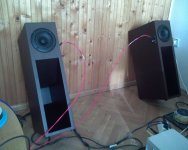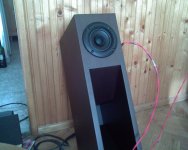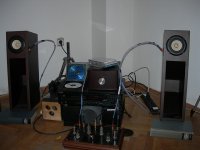Excellent response .....
for such a tiny driver. Have you considered a version with the mouth on the rear side of the cabinet? This further directs any midrange from the horm mouth away from the listener and also directs the lowest frequencies into the corners or side wall for greater coupling. How high up into the midrange do you think is escaping the horn mouth? Regards Moray James.
for such a tiny driver. Have you considered a version with the mouth on the rear side of the cabinet? This further directs any midrange from the horm mouth away from the listener and also directs the lowest frequencies into the corners or side wall for greater coupling. How high up into the midrange do you think is escaping the horn mouth? Regards Moray James.
Doing a very rough simulation with Hornresp (i.e. factory specs and exponential approx from throat to mouth, no folds)
it predicts (eyeball approximation)
55hz to 250hz -3db
and
50hz to 350hz -10db
seems fairly close to your actual measurements.
Good job.
The only thing I would note is that in a baffle that is only 5 inches wide the bafflestep should be around 900hz. Thus you will likely have a shallow dip from 350 to 900. A suprabaffle of about 12 inches should level this out if you want to try it.
Sean
it predicts (eyeball approximation)
55hz to 250hz -3db
and
50hz to 350hz -10db
seems fairly close to your actual measurements.
Good job.
The only thing I would note is that in a baffle that is only 5 inches wide the bafflestep should be around 900hz. Thus you will likely have a shallow dip from 350 to 900. A suprabaffle of about 12 inches should level this out if you want to try it.
Sean
How about this?
horns start to become efficient at 1/2 WL. Your horn design is 1.5 metres long which is about a 1/4 metre short of 1/2 WL. If you turn your cabinet design around so the mouth faces backwards and then place the driver on the top firing forwards using a very small cavity you can then extend the horn back from the driver at a downward angle into the section that currently holds the driver. This will give you more than enough extra length to exceed 1.77m (1/2 WL of 97 Hz). You would of course need to reposition the other sections to correct for the new length and expansion but your basic configuration is preserved. The overall length is increased and the driver fires forward and the mouth backwards. Any mid frequencies now vent to the wall behind the driver not the listener. The physical height of the driver is now in line with ear level at seating position so you no longer have to tilt the cabinets up as in your pictures. Further you gain some extra folds in the horn which should further reduce midrange output from the mouth. What do you think? Regards Moray James.
PS this is an exponential expansion, yes?
horns start to become efficient at 1/2 WL. Your horn design is 1.5 metres long which is about a 1/4 metre short of 1/2 WL. If you turn your cabinet design around so the mouth faces backwards and then place the driver on the top firing forwards using a very small cavity you can then extend the horn back from the driver at a downward angle into the section that currently holds the driver. This will give you more than enough extra length to exceed 1.77m (1/2 WL of 97 Hz). You would of course need to reposition the other sections to correct for the new length and expansion but your basic configuration is preserved. The overall length is increased and the driver fires forward and the mouth backwards. Any mid frequencies now vent to the wall behind the driver not the listener. The physical height of the driver is now in line with ear level at seating position so you no longer have to tilt the cabinets up as in your pictures. Further you gain some extra folds in the horn which should further reduce midrange output from the mouth. What do you think? Regards Moray James.
PS this is an exponential expansion, yes?
Visaton FR10 data...
Technical Data:
Rated power 20 Watt
Maximum power 30 Watt
Nominal impedance Z 8 Ohm
Frequency response 80 - 20000 Hz
Mean sound pressure level 86 dB (1W/1m)
Maximum cone displacement 8 mm
Resonance frequency fs 97 Hz
Magnetic induction 0,95 Tesla
Magnetic flux 180 µ Weber
Height of front pole-plate 3 mm
Voice coil diameter 2 cm
Height of winding 0,6 cm
Cutout diameter 10 cm
Net weight 0,38 kg
D.C. resistance Rdc 7,2 Ohm
Mechanical Q factor Qms 2,23
Electrical Q factor Qes 1,17
Total Q factor Qts 0,77
Equivalent volume Vas 1,7 l
Effective piston area Sd 50 cm2
Dynamically moved mass Mms 5,7 g
Force factor Bxl 4,61 T · m
Inductance of the voice coil L 0,55 mH
A Fostex FE126E has an Fs of 70 Hz and a Qts of 0.25. The Qts is better suited to horn loaded than is the much higher Visaton driver. 70 Hz is equal to 4.9 metres so 1/2 WL would be 2.45 metres. This could be achieved with a similar design layout nicely. Regards Moray James.
Technical Data:
Rated power 20 Watt
Maximum power 30 Watt
Nominal impedance Z 8 Ohm
Frequency response 80 - 20000 Hz
Mean sound pressure level 86 dB (1W/1m)
Maximum cone displacement 8 mm
Resonance frequency fs 97 Hz
Magnetic induction 0,95 Tesla
Magnetic flux 180 µ Weber
Height of front pole-plate 3 mm
Voice coil diameter 2 cm
Height of winding 0,6 cm
Cutout diameter 10 cm
Net weight 0,38 kg
D.C. resistance Rdc 7,2 Ohm
Mechanical Q factor Qms 2,23
Electrical Q factor Qes 1,17
Total Q factor Qts 0,77
Equivalent volume Vas 1,7 l
Effective piston area Sd 50 cm2
Dynamically moved mass Mms 5,7 g
Force factor Bxl 4,61 T · m
Inductance of the voice coil L 0,55 mH
A Fostex FE126E has an Fs of 70 Hz and a Qts of 0.25. The Qts is better suited to horn loaded than is the much higher Visaton driver. 70 Hz is equal to 4.9 metres so 1/2 WL would be 2.45 metres. This could be achieved with a similar design layout nicely. Regards Moray James.
Hi,
thanks for the data.
This just proves that horns are very tolerant of driver parameters.
Looking through the numbers, some jump out and yet your horn loaded driver works.
Fs=97Hz, but bass to 50Hz
Qts=.77 >> 0.2 to 0.4
Xmax=1.5mm
Bl=4.6 <<15 to 20
and all this performance from a truncated horn and tiny full range driver.
How good would it be with a nearer full size horn length and mouth?
I agree, a 200mm taller cabinet would extend the length. If it could be built tapered, then the mouth would be wider as well.
thanks for the data.
This just proves that horns are very tolerant of driver parameters.
Looking through the numbers, some jump out and yet your horn loaded driver works.
Fs=97Hz, but bass to 50Hz
Qts=.77 >> 0.2 to 0.4
Xmax=1.5mm
Bl=4.6 <<15 to 20
and all this performance from a truncated horn and tiny full range driver.
How good would it be with a nearer full size horn length and mouth?
I agree, a 200mm taller cabinet would extend the length. If it could be built tapered, then the mouth would be wider as well.
FR 10 /8 is cheap but middling driver. http://www.visaton.com/en/chassis_zubehoer/breitband/fr_8.html
AndrewT said:
...
Fs=97Hz, but bass to 50Hz
Qts=.77 >> 0.2 to 0.4
Xmax=1.5mm
Bl=4.6 <<15 to 20
...
Technical data by Visaton:
Rated power 20 W
Maximum power 30 W
Nominal impedance Z 8 Ohm
Frequency response 80–20000 Hz
Mean sound pressure level 86 dB (1 W/1 m)
Maximum cone displacement 8 mm
Resonance frequency fs 88 Hz
Magnetic induction 0,95 T
Magnetic flux 180 µWb
Height of front pole-plate 3 mm
Voice coil diameter 20 mm
Height of winding 6 mm
Cutout diameter 100 mm
Net weight 0,38 kg
D.C. resistance Rdc 7,2 Ohm
Mechanical Q factor Qms 2,29
Electrical Q factor Qes 0,95
Total Q factor Qts 0,67
Equivalent volume Vas 2,3 l
Effective piston area Sd 50 cm²
Dynamically moved mass Mms 5,7 g
Force factor Bxl 4,6 T m
Inductance of the voice coil L 0,2 mH
Sorry I was in error...
the 2.45 metres that I gave is in error. That was for half a wave length which was correct. However a horn will end up being somewhat longer than this. Will see if I can track down and accurate length in case anyone is interested in persuing this. Regards Moray James.
the 2.45 metres that I gave is in error. That was for half a wave length which was correct. However a horn will end up being somewhat longer than this. Will see if I can track down and accurate length in case anyone is interested in persuing this. Regards Moray James.
AndrewT said:Hi,
thanks for the data.
This just proves that horns are very tolerant of driver parameters.
I've used a driver with a Qts of 0,89 for a front loaded horn. Works very well, although the frequency response appeared to be uneven after some simulations.
High Q drivers can be used for horns but efficiency will decrease as well as bandwidth and usually the frequency response will be less flat.
Just found this thread, know it's a bit old, but I've recently used an FR10 in a small transmission line enclosure (triple folded). Mid range was a bit shouty and top end a bit coloured and harsh. Added a small tweeter, much better balance. Also used same enclosure with Hi-Vi B3N 3" full range driver. Not a great success!
See here on my site/blog:
http://sites.google.com/site/stevesstuffproject/sra-3tl-diy-bookshelf-loudspeaker
Thanks
See here on my site/blog:
http://sites.google.com/site/stevesstuffproject/sra-3tl-diy-bookshelf-loudspeaker
Thanks
- Status
- This old topic is closed. If you want to reopen this topic, contact a moderator using the "Report Post" button.
- Home
- Loudspeakers
- Full Range
- Low cost BL mini horn with Visaton FR10


